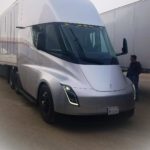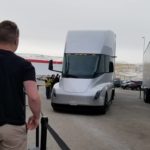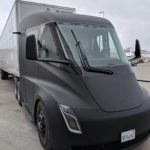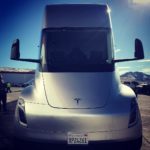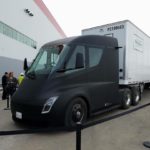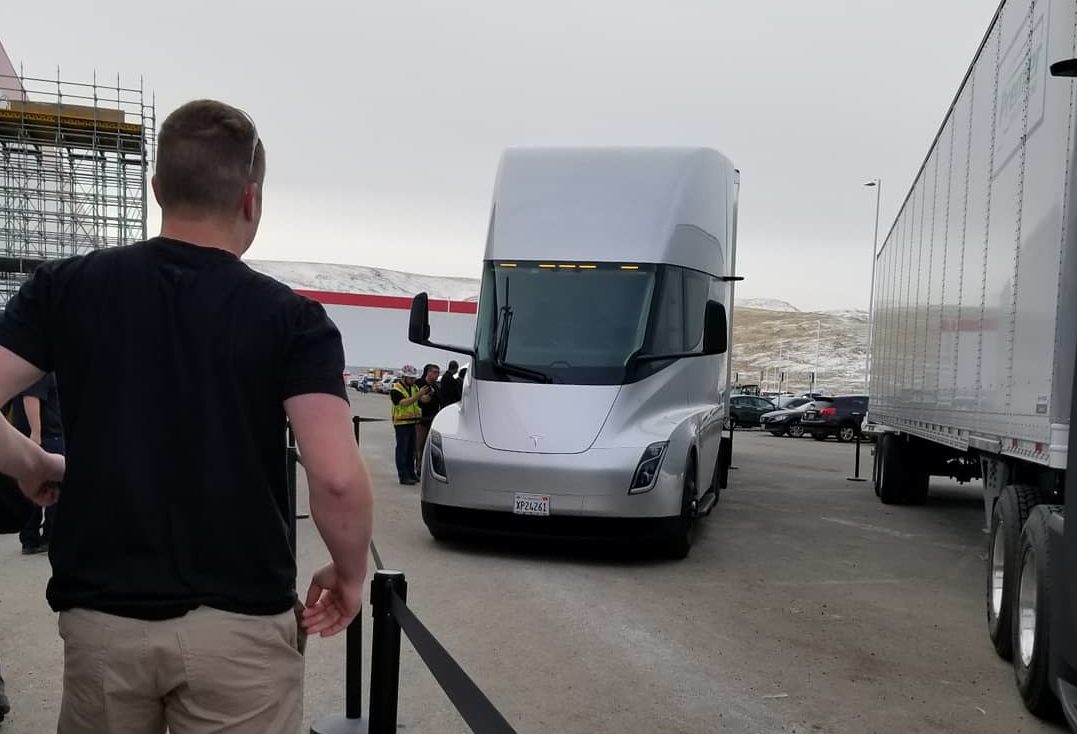
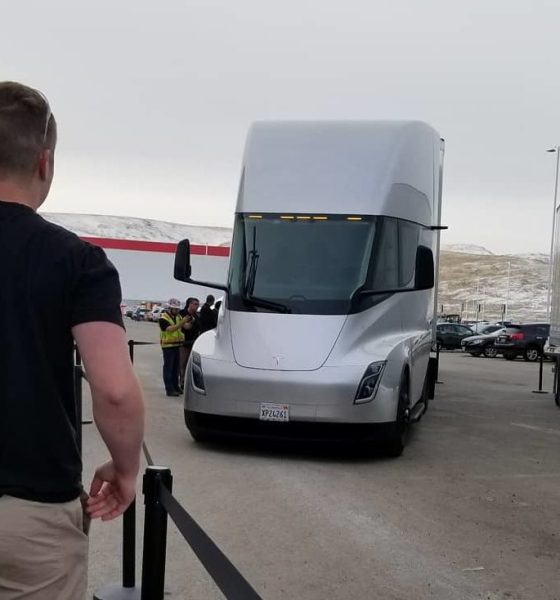
News
Tesla Semi begins production cargo runs from Gigafactory 1 to Fremont factory
Tesla CEO Elon Musk has revealed the first photo of a Tesla Semi, with a trailer full of battery packs in tow, that’s on its way to complete the first production cargo trip for the company. The news follows our recent report that a Tesla Semi was spotted traveling between the company’s Fremont, Calif. factory and Gigafactory facility in Sparks, Nevada.
“First production cargo trip of the Tesla Semi heavy-duty truck, carrying battery packs from the Gigafactory in the Nevada mountains to the car factory in California,” said Musk in his Instagram post.
A silver Tesla Semi, the company’s 500-mile all-electric long-range hauler – the same version that was recently spotted doing a tire-shredding acceleration run – and shorter range electric truck in Matte Black, can be seen in Musk’s photo. The all-electric trucks are framed by the unmistakable Nevada mountains surrounding the Gigafactory.
https://www.instagram.com/p/BgCJlKbFckb/
With a distance spanning just over 250 miles (400 km) between Tesla’s Nevada-based battery facility and its Fremont factory, both the long-range and shorter range Tesla Semi can presumably travel the entire length without needing to recharge.
Considering the over 4,000 feet total elevation drop from Tesla’s Gigafactory 1 and its California factory, Tesla Semi’s regenerative braking system would recapture loss energy on descents and result in a range increase in certain areas of the journey.
RELATED: Tesla Semi’s battery pack and overall weight explored
Today’s reveal by Musk validates a statement made by Tesla’s VP of Truck programs Jerome Guillen when he revealed that the company would become its own Tesla Semi customers by using the vehicles to transport components between its facilities.
“Tesla will be the first customer for its own truck. So we will use our own trucks to carry cargo in the US between our different facilities. We have (an) assembly factory in California, we have a battery factory in Nevada, so we’ll use our truck to carry things in between,” said Guillen when speaking at a summit in The Netherlands late last year.
- [Photo: proper_hanniel via Instagram]
- [Photo: momisflor via Instagram]
- [Photo: goochenator via Instagram]
- [Photo: mattyplop via Instagram]
- [Photo: dmackdaddy via Instagram]
Production of the Tesla Semi is expected to take place sometime in 2019. The company is working with its largest customers on the design and build out of its ultra-high powered Megacharger, The Tesla Semi charging stations will be installed at key locations that are frequently traveled by fleet operators and spaced close enough together so that Tesla Semi drivers have enough range to return back to their loading docks without needing to recharge.
PepsiCo, one of the largest Tesla Semi customers to date having ordered 100 trucks, noted that an agreement to share charging facilities for the Semi would help the electric truck service a wider area.
“We have a lot of in-house capability around energy and engineering, and certainly, Tesla brings their expertise to the table on energy and charging,” said PepsiCo executive Mike O‘Connell.
Other high-profile companies such as UPS, UAE-based Bee’ah and Norway’s Postal Service, among many smaller operations, have committed to reducing their operations environmental impact by either replacing or augmenting their fleet with Tesla Semi trucks.

News
Tesla FSD fleet is nearing 7 billion total miles, including 2.5 billion city miles
As can be seen on Tesla’s official FSD webpage, vehicles equipped with the system have now navigated over 6.99 billion miles.

Tesla’s Full Self-Driving (Supervised) fleet is closing in on almost 7 billion total miles driven, as per data posted by the company on its official FSD webpage.
These figures hint at the massive scale of data fueling Tesla’s rapid FSD improvements, which have been quite notable as of late.
FSD mileage milestones
As can be seen on Tesla’s official FSD webpage, vehicles equipped with the system have now navigated over 6.99 billion miles. Tesla owner and avid FSD tester Whole Mars Catalog also shared a screenshot indicating that from the nearly 7 billion miles traveled by the FSD fleet, more than 2.5 billion miles were driven inside cities.
City miles are particularly valuable for complex urban scenarios like unprotected turns, pedestrian interactions, and traffic lights. This is also the difference-maker for FSD, as only complex solutions, such as Waymo’s self-driving taxis, operate similarly on inner-city streets. And even then, incidents such as the San Francisco blackouts have proven challenging for sensor-rich vehicles like Waymos.
Tesla’s data edge
Tesla has a number of advantages in the autonomous vehicle sector, one of which is the size of its fleet and the number of vehicles training FSD on real-world roads. Tesla’s nearly 7 billion FSD miles then allow the company to roll out updates that make its vehicles behave like they are being driven by experienced drivers, even if they are operating on their own.
So notable are Tesla’s improvements to FSD that NVIDIA Director of Robotics Jim Fan, after experiencing FSD v14, noted that the system is the first AI that passes what he described as a “Physical Turing Test.”
“Despite knowing exactly how robot learning works, I still find it magical watching the steering wheel turn by itself. First it feels surreal, next it becomes routine. Then, like the smartphone, taking it away actively hurts. This is how humanity gets rewired and glued to god-like technologies,” Fan wrote in a post on X.
News
Tesla starts showing how FSD will change lives in Europe
Local officials tested the system on narrow country roads and were impressed by FSD’s smooth, human-like driving, with some calling the service a game-changer for everyday life in areas that are far from urban centers.

Tesla has launched Europe’s first public shuttle service using Full Self-Driving (Supervised) in the rural Eifelkreis Bitburg-Prüm region of Germany, demonstrating how the technology can restore independence and mobility for people who struggle with limited transport options.
Local officials tested the system on narrow country roads and were impressed by FSD’s smooth, human-like driving, with some calling the service a game-changer for everyday life in areas that are far from urban centers.
Officials see real impact on rural residents
Arzfeld Mayor Johannes Kuhl and District Administrator Andreas Kruppert personally tested the Tesla shuttle service. This allowed them to see just how well FSD navigated winding lanes and rural roads confidently. Kruppert said, “Autonomous driving sounds like science fiction to many, but we simply see here that it works totally well in rural regions too.” Kuhl, for his part, also noted that FSD “feels like a very experienced driver.”
The pilot complements the area’s “Citizen Bus” program, which provides on-demand rides for elderly residents who can no longer drive themselves. Tesla Europe shared a video of a demonstration of the service, highlighting how FSD gives people their freedom back, even in places where public transport is not as prevalent.
What the Ministry for Economic Affairs and Transport says
Rhineland-Palatinate’s Minister Daniela Schmitt supported the project, praising the collaboration that made this “first of its kind in Europe” possible. As per the ministry, the rural rollout for the service shows FSD’s potential beyond major cities, and it delivers tangible benefits like grocery runs, doctor visits, and social connections for isolated residents.
“Reliable and flexible mobility is especially vital in rural areas. With the launch of a shuttle service using self-driving vehicles (FSD supervised) by Tesla in the Eifelkreis Bitburg-Prüm, an innovative pilot project is now getting underway that complements local community bus services. It is the first project of its kind in Europe.
“The result is a real gain for rural mobility: greater accessibility, more flexibility and tangible benefits for everyday life. A strong signal for innovation, cooperation and future-oriented mobility beyond urban centers,” the ministry wrote in a LinkedIn post.
News
Tesla China quietly posts Robotaxi-related job listing
Tesla China is currently seeking a Low Voltage Electrical Engineer to work on circuit board design for the company’s autonomous vehicles.

Tesla has posted a new job listing in Shanghai explicitly tied to its Robotaxi program, fueling speculation that the company is preparing to launch its dedicated autonomous ride-hailing service in China.
As noted in the listing, Tesla China is currently seeking a Low Voltage Electrical Engineer to work on circuit board design for the company’s autonomous vehicles.
Robotaxi-specific role
The listing, which was shared on social media platform X by industry watcher @tslaming, suggested that Tesla China is looking to fill the role urgently. The job listing itself specifically mentions that the person hired for the role will be working on the Low Voltage Hardware team, which would design the circuit boards that would serve as the nervous system of the Robotaxi.
Key tasks for the role, as indicated in the job listing, include collaboration with PCB layout, firmware, mechanical, program management, and validation teams, among other responsibilities. The role is based in Shanghai.
China Robotaxi launch
China represents a massive potential market for robotaxis, with its dense urban centers and supportive policies in select cities. Tesla has limited permission to roll out FSD in the country, though despite this, its vehicles have been hailed as among the best in the market when it comes to autonomous features. So far, at least, it appears that China supports Tesla’s FSD and Robotaxi rollout.
This was hinted at in November, when Tesla brought the Cybercab to the 8th China International Import Expo (CIIE) in Shanghai, marking the first time that the autonomous two-seater was brought to the Asia-Pacific region. The vehicle, despite not having a release date in China, received a significant amount of interest among the event’s attendees.
